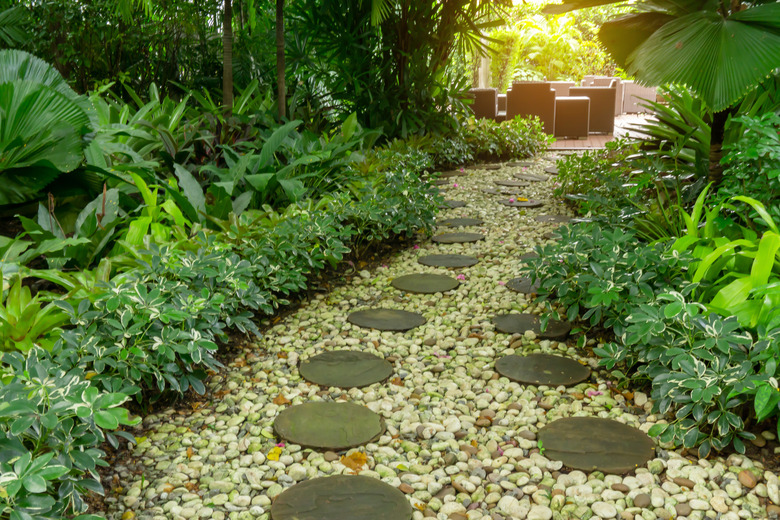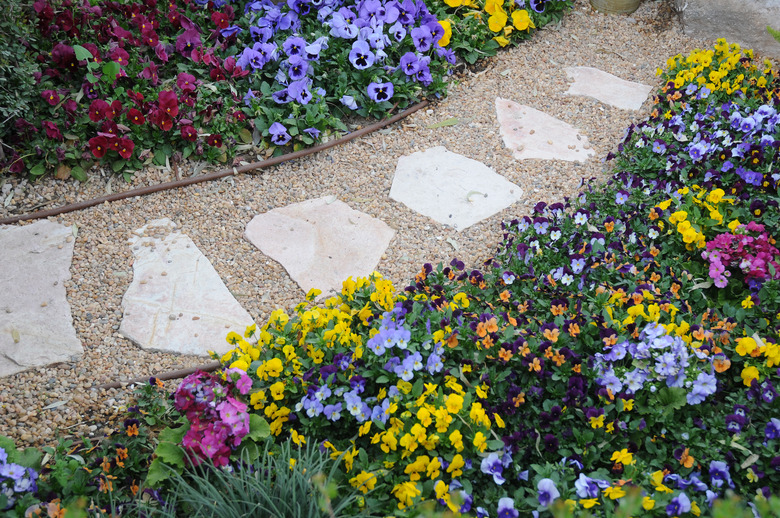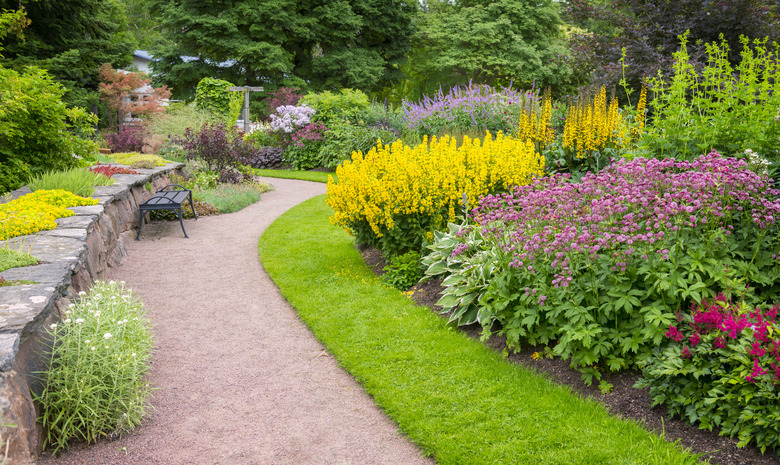Garden Paths, Walkways And Steps In Your Landscape
Residential landscaping often includes features such as a garden path, walkway or steps in the overall design. These elements are two fold: A garden path or walkway is practical (no one wants to step in mushy ground after a rain storm) and decorative—giving shape to a side yard, breaking up a large backyard area or providing a scenic route through your prized flowerbeds. The layout and materials used for your garden path will vary depending on the overall effect desired, the amount of foot traffic expected on the path and the function of the space the path serves. A large variety of materials can be used for these projects depending on your aesthetic as well as your budget.
Prior to starting any outdoor project where digging is involved for DIY projects, be sure to have the utilities marked. The national "call before you dig" telephone number in the United States is 811. Call this number before beginning work to make sure all of the utility lines are properly marked so that any digging can be completed safely.
Types of Garden Paths and Steps
Any area that approaches the front entrance of the home needs to be well-constructed, sturdy and appealing. The foot traffic will be heaviest on this pathway, so consider that when choosing materials. Many homeowners choose to pour concrete sidewalks and add decorative plantings for visual interest, but there are other options as well. Pavers can be a more expensive (and sometimes more labor-intensive) choice, but they add significant curb appeal and a higher-end look to the front of the house.
A garden walkway may be more decorative than practical, although if the garden is used for fruits, vegetables and herbs, it could see more foot traffic. These paths range from the practical to the whimsical and should be planned around the amount of use they will get on a regular basis. For example, a cutting garden of flowers would do well with a simple design of stepping stones and ground cover — just enough to keep feet out of mud and add a little visual interest. Side yards also tend to have minimal foot traffic, so selectively placed flagstones surrounded by mulch or other ground cover could work well.
Backyards are often a medium-traffic area depending on the layout of the property. Here it's important to balance the practical with the visual. For example, if there's a path to the garage, it should feature solid construction and minimal hazards to reduce the risk of tripping when coming and going from the home. That said, a simple backyard sitting area with a fire pit off to the side might be just fine with a gravel path edged with some natural stone or other material.
Depending on the topography of the property, some steps may be required. These steps can range from functional stairs that lead to the entryway of the home to simple steps that bridge a slight gap in elevation in a side yard or backyard area. Steps are functional first, but they can also be constructed to be visually appealing. If they need to be added to the scope of a project, it can significantly increase the cost and the amount of work depending on what is required.
Common Walkway and Step Materials
There are numerous types of materials available for walkways, paths and steps. They range from plants to loose cover, natural stones and man-made options. Knowing what is out there can help when trying to narrow the field for an initial design concept. It's also possible to mix and match materials depending on the overall effect that is desired.
Some live plants are sturdy enough to act as a walkway ground cover. These tough plantings tend to be more decorative and lower maintenance than turf options like grass. Fine Gardening highlights ornamental thymes and blue star creeper as excellent choices for pathway areas but be sure to select an option that works well for your climate. Certain types of sedum and Irish moss can be good for lower-traffic paths. Talk with a garden store about local options. It can provide some advice about natives that thrive in your climate.
Loose materials such as mulch or pea gravel can make great fill for walkway areas. These may need to be replenished periodically. Mulch will eventually decompose, and gravel tends to sink into the ground over time. Wood can also be incorporated in a pathway design either as "slices" of wood from trees or by using the ever-popular (and inexpensive) wood from an old pallet or two. Again, wood will decompose over time, so be sure to keep that in mind when making your selections.
Stone and brick pavers come in a wide range of sizes and shades and are extremely durable pathway materials. They are also sometimes used in the construction of exterior steps in a landscape design, as are slabs of granite and other heavy-duty materials. Bluestone has become a popular step material, and formed concrete is also used fairly often. The latter can even be colored to add interest. Stepping stones make a lovely decorative pick, and flagstone remains a common choice for walkways as well as for patio areas.
Finalizing a Pathway Design
Before finalizing any exterior landscape design, it's necessary to create an overall plan for the types of materials that will be used. There are many different choices for these types of projects, and decisions are often made based on criteria such as appearance, functionality and budget. Other factors to consider include the complexity of installation and the size of the area available for the path, walkway or steps.
Since front walkways tend to have heavy traffic and need to be sturdy and easy to walk on for residents and visitors alike, it makes sense to craft these areas with the more stable materials that are available. A brick walkway or stone walkway can be a good choice. Concrete is another smart pick for the area in front of the house. All of these materials tend to be more low maintenance and require less in terms of ongoing costs. Much of the expense is up front.
Garden paths for side yards or backyards can be a little less involved, as they generally receive less traffic. A combination of edging and mulch can be a simple, inexpensive solution. A selection of scattered stepping stones with some hardy ground-cover plants can also work well. Loose stone and gravel are other common choices for these areas and aren't too costly.
The work of finding and pricing materials is part of the design process. If it's a small project, a home improvement store may have everything that you need. For larger-scale work, it could be cost efficient to investigate landscape material companies that sell gravel, stone and other materials in bulk at reasonable rates. Many landscape suppliers offer delivery for large orders.
Don't forget to factor in other costs needed for the design, such as landscaping cloth and pins, mortar or other elements that will need to be included. Projects such as laying pavers require a base layer of gravel and sand to help ensure they will stay put, remain level and drain properly once installed. The cost of these items can add up, so it's best to be aware of them before deciding on the final design.
Tips for DIY Walkway Projects
There are so many different ways to customize a walkway or path area. One great way to get some basic ideas is to browse Pinterest. Those planning to DIY this type of project might find the book Patios and Walkways helpful for the more technical information, such as step construction or choosing materials that make sense for a particular type of job. It's good to know the skills required for each project ahead of time to help make the decision of whether to take on the work or hire someone else to do it. Some of the work can be very labor intensive.
Stepping stones can be a great DIY project for a side yard or a garden path. There are plenty of online tutorials with unique ideas for making them in a variety of shapes and sizes. Decorative objects can be embedded into the material to customize the look, and making them at home can be a fun project for children as well as adults. The stepping stones can be made in many different shapes and sizes.
Quikrete offers several decorative forms that homeowners can use to make their own pathways simply and easily. The company also provides some information on decorative effects and coloring the material. It offers a country stone pattern, several different types of brick layouts and step-by-step instructions for creating a pathway design. This could be a great solution for a backyard path.
Simple tricks such as using a garden hose to map the outline of the pathway can work wonders. Since nature doesn't operate in straight lines, this can help you create a more natural look for the walkway. If a straight path is desired, measure and map the walkway using stakes and string to keep things even and in line.
Don't overlook those extras that will add interest to a path or walkway. These items include everything from attractive border plants to border fences to landscape lighting. Each of these elements can increase the appeal of the walkway itself. Also be sure and think through how the path will be edged, as that keeps everything looking neat and tidy. There are options ranging from plastic edging to masonry edging.
A Word About Exterior Steps
Step materials can vary widely based on the number of steps that need to be installed as well as the budget. If just a couple of steps are needed in a low-traffic area, timbers or granite slabs could work perfectly. If there are going to be multiple steps, a retaining wall will likely need to be incorporated in the design along with some type of sturdy step material, such as bluestone, concrete or brick. Stairs and steps can become a fairly involved project when more than a few of them are needed. Keep that in mind when doing the planning.
It's important to note that some basic knowledge of how to create a safe structural design for the foundation is needed for successful step installation. Putting in a couple of steps in a backyard is a far less demanding project than constructing a front walkway with multiple steps leading to a front door or providing access from a public sidewalk. It may be wise to hire out for this, depending on the degree of difficulty. Also, be sure to check local codes to see if a railing is required for the number of steps being installed.


